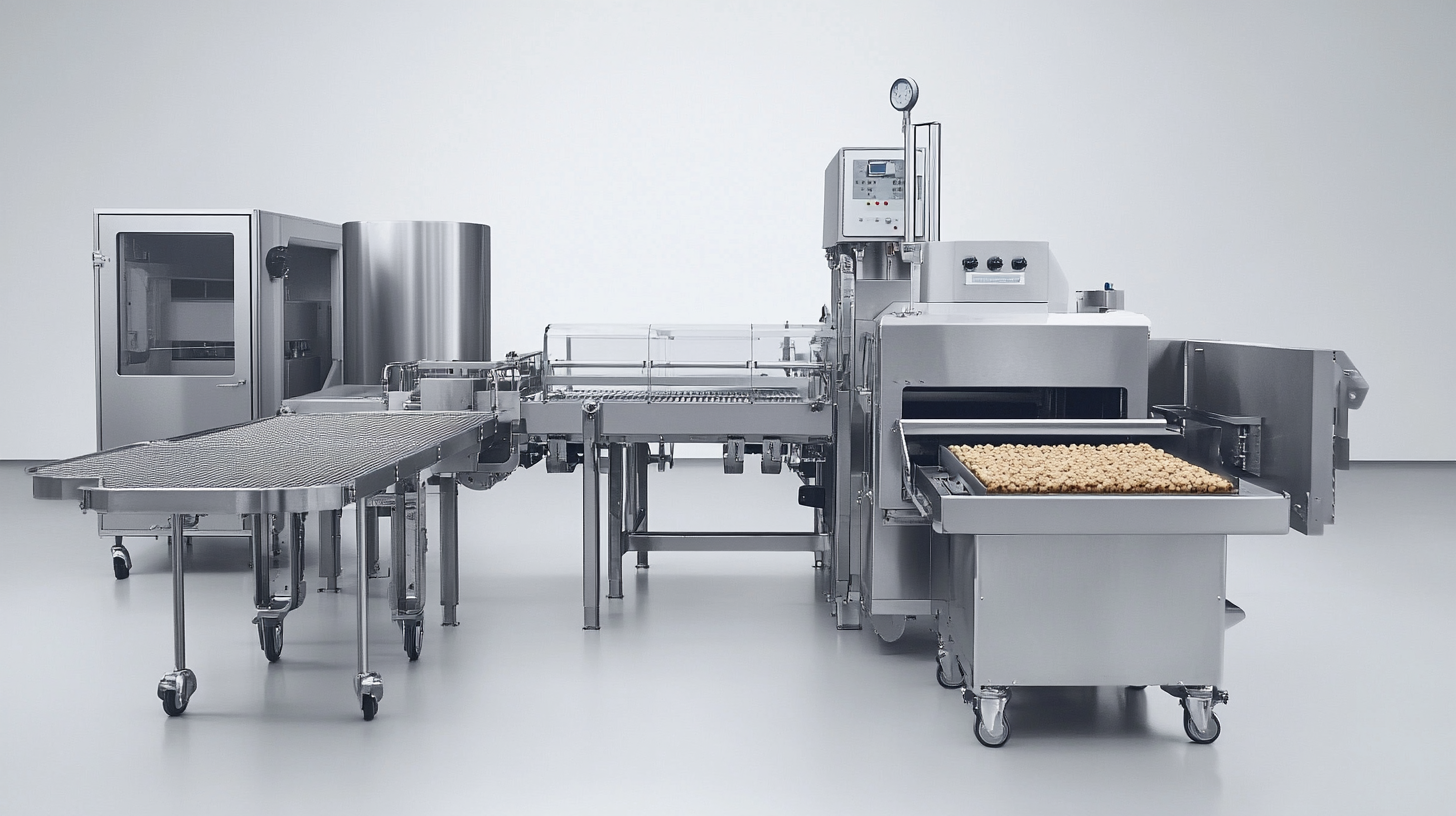
In recent years, the global market for finger chips fry machines has witnessed significant growth, driven by increasing consumer demand for convenience foods and the rise of quick-service restaurants. According to a report by Research and Markets, the global snack food machinery market is projected to grow at a CAGR of approximately 5.4% from 2020 to 2025. This surge in demand has led manufacturers to innovate and enhance the efficiency, quality, and versatility of finger chips fry machines. As a result, global buyers must navigate a complex landscape of options to select the best equipment that meets their needs.
When selecting a finger chips fry machine, buyers should consider several critical factors that can influence production efficiency and food quality. Industry insights highlight the importance of technology, energy efficiency, and ease of maintenance as key criteria. The International Journal of Food Engineering emphasizes that modern fry machines equipped with advanced temperature control systems and automated processing functions can significantly enhance the frying process, leading to better texture and flavor profiles in the final product. Therefore, understanding these best practices in finger chips fry machine selection is essential for ensuring operational success and maintaining a competitive edge in the ever-evolving snack food market.

The finger chips fry machine market is witnessing significant changes fueled by various trends and statistics that shed light on the industry's dynamics. With nearly half of U.S. potatoes now being allocated for frozen products, particularly french fries, the demand for efficient frying machinery has surged. This shift highlights the necessity for global buyers to understand the best practices in selecting finger chips fry machines that cater to this evolving market.
In 2024, the U.S. potato production is projected to decline to 417.8 million cwt, primarily due to reduced acreage and yield. This decrease creates both challenges and opportunities for manufacturers of frying machines. As the global frozen potato market is anticipated to grow from USD 67.27 billion in 2023 to USD 89.51 billion by 2029, there is an increasing need for machinery that can adapt to higher volumes and maintain product quality amidst price volatility.
In response to these market trends, innovations in technology, such as automation in frying processes, have emerged as essential factors in machine selection. As companies strive to meet the growing demand for quality frozen french fries, manufacturers are investing in state-of-the-art finger chips fry machines that enhance efficiency and productivity. Global buyers must stay informed about these technological advancements and their implications for maintaining competitive edge in this fast-evolving market.
When selecting high-quality fry machines for finger chips, several crucial factors come into play. One of the primary considerations is the type of frying medium used. Recent studies have highlighted the potential of alternative frying media, such as oleogels, which can significantly reduce fat uptake during the frying process. This is particularly relevant in today’s health-conscious market, where consumers are increasingly looking for lower-fat options. By choosing fry machines that accommodate diverse frying mediums, buyers can enhance not only the nutritional profile of their products but also improve overall flavor and texture.
Another essential factor is the efficiency and technology of the fry machine itself. According to industry reports, advanced fry machines equipped with state-of-the-art technology can optimize frying times and temperatures, leading to improved energy consumption. This not only contributes to lower operational costs but also minimizes the carbon footprint of manufacturing processes. Additionally, machines designed with better oil filtration and circulation systems can prolong oil life, reducing the frequency of oil changes and enhancing product consistency.
Lastly, the layout and setup of a fry plant should not be overlooked. A detailed analysis presented in recent manufacturing reports emphasizes that a well-designed workflow can increase productivity and reduce waste. Global buyers should seek fry machines that integrate easily into their existing operations while offering scalability as production demands grow. By focusing on these factors, businesses can make informed decisions that align with both operational efficiency and consumer expectations in the competitive market of finger chips.
When selecting finger chips fry machines, energy efficiency stands out as a critical factor for global buyers. With electric energy costs rising globally, manufacturers are increasingly focusing on machines that not only produce high-quality products but also minimize energy consumption. According to a report by the International Energy Agency (IEA), the food processing industry accounts for nearly 10% of global industrial energy use, underscoring the potential savings from adopting energy-efficient technology.
For instance, energy-efficient fryers can reduce energy consumption by up to 50% compared to traditional frying methods. This drastic reduction not only lowers operational costs but also enhances the overall sustainability of production processes. Manufacturers employing these advanced machines have reported reductions in annual energy bills by thousands of dollars, which can significantly improve profit margins. Additionally, these machines typically incorporate features such as insulation and energy recovery systems, which further contribute to their efficiency.
Moreover, the long-term impact of energy-efficient frying technology extends beyond cost savings. A study from the Food and Agriculture Organization (FAO) indicated that implementing energy-efficient equipment can decrease greenhouse gas emissions by up to 30% in the food industry. As consumers increasingly favor companies that demonstrate environmental responsibility, investing in energy-efficient fry machines not only caters to cost management but also aligns with sustainable practices, enhancing brand image and customer loyalty in an eco-conscious market.

When it comes to selecting a finger chips fry machine, buyers often face the critical decision between automatic and manual options. Automatic fry machines are designed for efficiency and consistency, allowing for high volumes of production with minimal labor input. These machines feature programmable settings that ensure even frying and a uniform texture, making them ideal for large-scale operations where time and consistency are paramount. Additionally, automated systems often come equipped with advanced features such as temperature controls and timers, which can enhance overall product quality.
On the other hand, manual finger chips fry machines offer a level of control that some operators may prefer. These machines require more hands-on involvement, which allows for adjustments based on real-time observations of the frying process. This flexibility can be beneficial for smaller batches or artisanal producers who prioritize craftsmanship over volume. Manual fry machines also tend to be more cost-effective, making them a suitable option for start-ups or businesses exploring entry into the finger chips market without a significant initial investment.
Ultimately, the choice between automatic and manual fry machines should align with the specific needs of the operation. Factors such as production volume, desired product quality, and budget constraints will guide buyers in making an informed decision. Understanding the strengths and limitations of each type helps ensure that the selected fry machine will deliver the best results for the intended business goals.

When selecting a fry machine for finger chips production, maintenance and durability are paramount considerations that can significantly influence the long-term success of your investment. According to a recent report by the Food and Agriculture Organization (FAO), proper maintenance can enhance the operational lifespan of fry machines by up to 40%. This means that buyers need to prioritize equipment that is designed with easy access for cleaning and servicing. Machines made with stainless steel components not only provide resistance to corrosion but are also easier to maintain than their counterparts made of materials prone to rust.
Moreover, the durability of fry machines has a direct impact on production efficiency and cost-effectiveness. A study by Grand View Research indicates that machines manufactured using high-quality materials and robust engineering can operate efficiently for over 10,000 hours without significant breakdowns. Buyers should be aware of the machine's warranty and service lifetime, opting for manufacturers that provide extensive support plans and readily available spare parts. These elements underscore the importance of investing in fry machines that are built to withstand the rigors of high-volume production while minimizing downtime.
In addition, the integration of advanced technology in frying processes can improve both maintenance and durability. Machines equipped with automatic cleaning systems and monitoring sensors can not only ease the maintenance burden but also extend the durability of critical components. By investing in technology that ensures optimal performance, global buyers can secure their operations against unexpected failures and maintain product quality over extended periods.
| Criteria | Considerations | Importance | Long-term Impact |
|---|---|---|---|
| Machine Durability | Material quality and construction | High | Reduces replacement costs |
| Maintenance Requirements | Ease of cleaning and servicing | Medium | Sustains operational efficiency |
| Energy Efficiency | Power consumption and savings | High | Lowers operational costs |
| Safety Features | Overheat protection, emergency stops | High | Protects users and prevents damage |
| Production Capacity | Output rate and batch size | Medium | Affects business scalability |